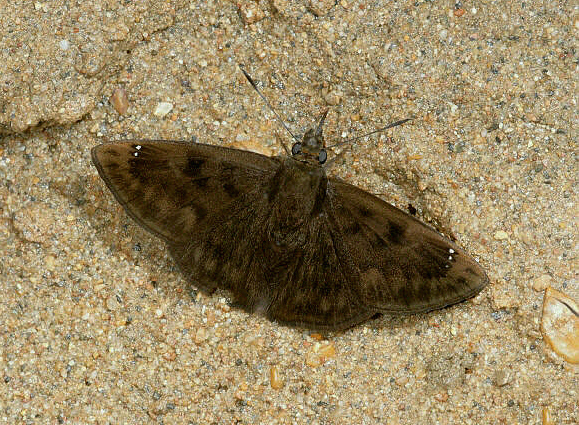
Introduction
The Pyrginae, popularly known as Flats or Spreadwings, are a cosmopolitan subfamily distributed across temperate and tropical habitats throughout the world. In the Americas there are 990 species, of which about 580 are assigned to the tribe Pyrgini.
The suffused but distinct markings, and the 3 whitish spots near the apex clearly identify the above illustrated butterfly as a member of the genus Nisoniades. It should be noted that there is another neotropical genus with an almost identical name – Niconiades ( Hesperiinae ).
There are 33 Nisoniades species, most of which are very similar in appearance, so determining the exact species from a photograph is almost impossible. To quote one of my contacts “most of the specimens in collections are just worn brown things”. This is one of the many skippers that can only be identified accurately by dissecting the genitalia, dissolving away the soft tissue, and examining the remaining chitinous organs under a powerful microscope.
Nisoniades evansi is found in Ecuador and Peru.
Habitats
This species was photographed at an estimated altitude of 250m, on a sandbank at Boca Manu, Rio Madre de Dios, Peru. This area comprises mainly of severely disturbed riparian forest. The butterfly is probably restricted to altitudes between about 150-600m, in primary and disturbed rainforest.
Lifecycle
Pyrgine butterflies typically lay their eggs singly on either the upperside or underside of leaves. The larvae are usually dull green or brownish, with thin longitudinal lines along the back and sides, and with black shiny heads. Most feed on low growing herbaceous plants, but a small percentage feed on the leaves of bushes or trees. The pupae are usually dark and smooth, with the wing cases in a contrasting tone or colour. They are normally formed within silken tents formed by spinning together the leaves of the foodplant.
Adult behaviour
This species is usually encountered singly amidst aggregations that include other sombre Pyrgines, imbibing mineralised moisture from river beaches.
